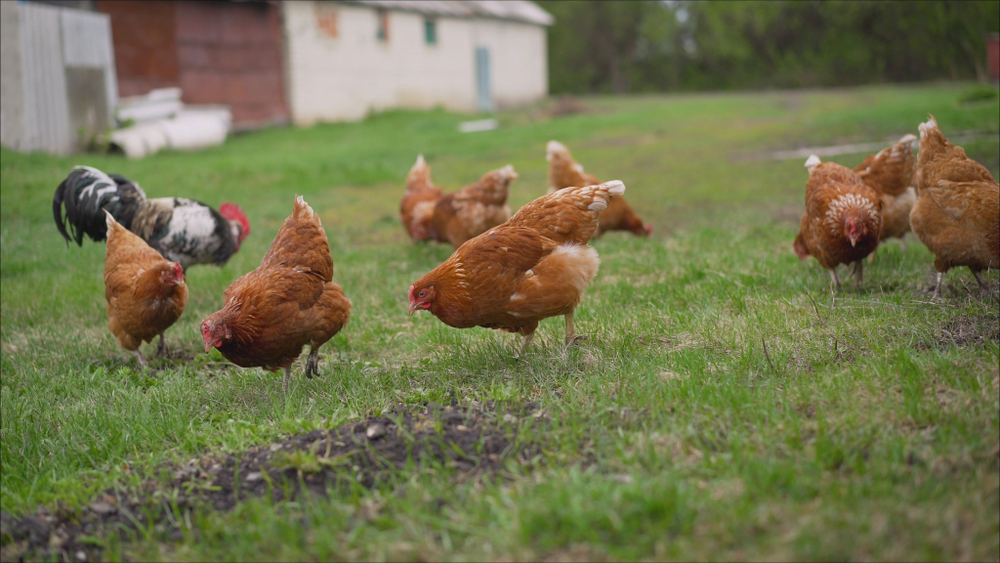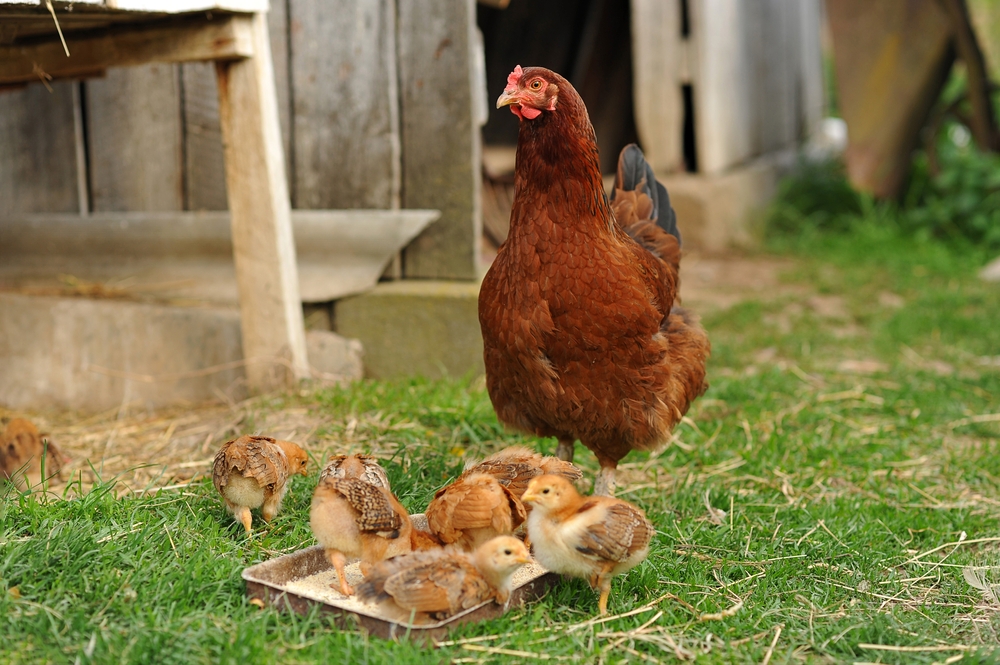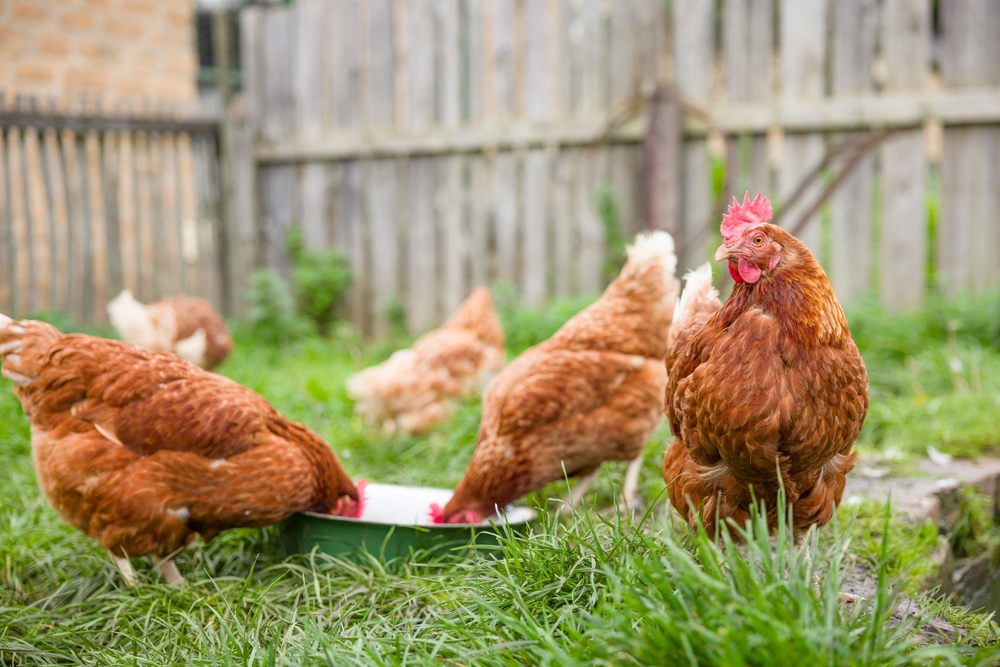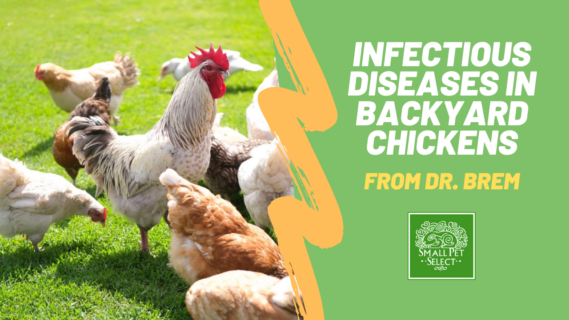Chickens can get sick just like dogs, cats, and other mammals can. Diseases in backyard chickens often require veterinary care. To ensure your chickens stay healthy, you should pay attention to anything unusual going on with them, such as changes in their skin, diarrhea or inappetence, coughing or other respiratory issues, and walking or behaving differently.
Skin Diseases In Backyard Chickens
Fowlpox
Fowlpox is a viral disease that can show up in several forms. The most common is the cutaneous (skin) form. This is characterized as raised white spots on the non-feathered skin that become yellow and scabby, sometimes combining into larger spots.
Often these spots are just on the legs and feet; however, if they develop on the eyelids they can cause closure of the eyes, and if they develop around the nostrils they can cause nasal discharge.
Fowlpox is transmitted by infected chickens contacting another chicken with open wounds and by insects, especially mosquito bites. Also, when scabs are shed in the chicken coop, other birds can breathe in the virus. Vaccination and insect control help prevent infection and spread.
Favus
Favus, or avian ringworm, is a fungal disease. Affected birds have white, chalk-like deposits on their combs (on the top of their heads), which can enlarge and combine to become a thick, moldy layer. If the disease is only on the comb, the comb typically heals by itself in a few months. However, if feathers are involved, the bird can die.
Favus is spread through contact with infected birds, other animals, people, soil, and contaminated objects. People can become infected with it as well. It’s treated with topical medications (powders, creams, ointments) that are applied directly to the affected areas.
Mite infestation
There are several types of poultry mites, which you can sometimes see as small red or black flecks on the skin or in bedding areas. Mites cause skin irritation, feather loss, and, because they suck on blood, anemia. You might also note bald spots on the skin, poor appetite, and a decrease in egg production.
Mites spread from chicken to chicken or from dirt in the chicken coop to birds. Permethrin is a common chemical treatment for mites. It can be applied directly to affected chickens and is also used in the coop. Note, however, that it is toxic to cats. Another effective treatment is Spinosad, a natural insecticide.
Tick Infestation
Similar to mites are ticks. When birds are heavily infected, ticks can cause anemia, temporary paralysis, and disease from bacteria in the tick’s saliva. Spraying buildings with insecticides such as permethrin or Spinosad and applying fipronil directly to birds are the treatments.
Note: fipronil is toxic to rabbits and other small mammals.
Intestinal Diseases In Backyard Chickens
Salmonellosis
Salmonellosis is a bacterial disease that causes diarrhea, weakness, poor appetite, and sometimes swollen joints and legs in mostly young chickens. Chickens become infected by pecking in contaminated soil.

They then pass the disease in their eggs, infecting the chicks and humans who eat the eggs raw. Chickens can become very ill and die, and those who survive become carriers of the disease, continuing to pass bacteria in their eggs.
To prevent salmonellosis, you should purchase your birds from a flock that is certified clean of salmonellosis. Treatment isn’t recommended since it can cause birds to become carriers.
Campylobacteriosis
Campylobacteriosis is a bacterial disease that is common in chickens but doesn’t cause them much harm. The most common sign in chickens is decreased egg production.
Campylobacteriosis does, however, cause serious illness in people if transmitted to them when they handle infected chickens. Transmission among chickens is through diarrhea-contaminated food, water, and insects. Treatment is mostly through prevention: keeping coops clean and eradicating insects, for example.
Colibacillosis
Colibacillosis is caused by the bacterium E. coli and is seen in all age groups of chickens. It affects the intestinal system but can also affect the respiratory and reproductive systems, causing signs such as diarrhea, pneumonia, yolk sack infection, and septicemia, which can result in death. It can be brought about by poor environmental conditions, inhaling contaminated dust, and stressful events.
To prevent disease, coops need to be kept extremely clean, ventilation must be adequate, and a pest-control program must be in place. Several antibiotics can be used to treat, and chickens usually survive if treated early.
Coccidiosis
Coccidiosis is caused by the parasite coccidia, which lives in the intestinal tract of chickens and in heavily soiled litter. Coccidiosis is usually seen in birds 1-4 months old. Signs include diarrhea, bloody diarrhea, loss of egg production, and death.

Transmission of the disease is through ingestion of contaminated feed. To help prevent it, the coop and yard should be kept clean and uncrowded. Also, preventative medication can be supplied in the feed, and vaccines are available. When an outbreak happens, anti-coccidia medication can be given.
Respiratory Diseases In Backyard Chickens
Mycoplasmosis
Mycoplasmosis is a bacterial infection that causes respiratory signs in chickens such as swelling of the face and around the eyes, eye discharge, coughing and sneezing, gasping, nasal discharge, and a purple hue to the face.
It is spread from bird to bird through contact with each other, by inhaling particles of the bacterium from contaminated dust or dander, and through contact with contaminated clothing or objects.
Prevention, as with most diseases, involves keeping a sanitized area. Vaccines are available in some states. Treatment is with several antibiotics; however, the disease often recurs when treatment stops (sometimes having to be re-treated once a month), and chickens who recover remain carriers.
Avian Influenza
Avian influenza, or bird flu, is a highly contagious viral disease that you may have heard about. There is a low pathogenic type, which usually causes only mild signs, and a highly pathogenic type, which is deadly.
Signs include gasping, nasal discharge, and facial swelling in addition to extreme diarrhea, soft and misshapen eggs, and purple discoloration of the skin.
Sudden death of a number of birds is a common indication of highly pathogenic avian influenza, and if this is noted your state veterinarian should be called immediately to test for infection.
Wild birds that live by water are hosts for the virus, meaning that they can have it without showing signs, and they can shed the virus as they fly over backyard flocks. It's then spread through respiratory droplets and contaminated food, water, or objects. There is no approved vaccine or treatment.

Infectious Bronchitis
Infectious bronchitis is caused by a virus and spreads rapidly in young chicks. Like with other respiratory diseases, signs include coughing, sneezing, nasal discharge, and gasping. In laying hens, egg production is reduced significantly and misshapen, thin shells are seen. If chickens are infected young, they may never lay eggs.
The virus is spread by breathing in infected air droplets, chicken-to-chicken contact, and by contaminated manure, water, food, or objects. Since infectious bronchitis is a virus, antibiotics do not treat it; however, they can be used to treat bacterial infections that often occur along with the virus.
Increasing the temperature of the coop can sometimes help. Vaccines are available to help prevent, but they are not perfect.
Neurological Diseases In Backyard Chickens
Marek’s Disease
Marek’s disease is one of the viral diseases in backyard chickens that affects their nerves and causes tumors of their organs and sometimes muscles and skin. It is most often seen in chickens 1-4 months old.
The most common signs are difficulty walking and incoordination (ataxia), paralysis, and splayed legs. Another sign is a grayish color change to the pupils, which indicates eye tumors.
The virus is spread primarily by breathing in infected dust or dander. It can also be spread through contaminated objects, by insects that live in litter, and on the hands or clothing of people. Vaccines are usually only effective if administered to chickens less than two weeks old, and there is no treatment.
Avian Encephalomyelitis
This hard-to-say viral disease most commonly affects chicks 1-3 weeks old. Signs include stumbling, incoordination, and falling down. It is spread mostly from hens to eggs but can also be spread from chicken to chicken by pecking at infected feces.
There is no treatment. Vaccination of hens (at least 4 weeks before they start laying eggs but after 8 weeks of age) to protect their chicks through maternal antibodies is vital for prevention. The disease is preventable if hens are vaccinated at the appropriate time.
Copyright 2024 Amy “Brem” Bremers, DVM





